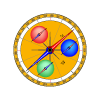Speaker
Sergio Scopetta
(Perugia Univ. & INFN)
Description
The time reversal-odd parton transverse momentum distributions (TMDs) in the neutron can be studied through semi-inclusive deep inelastic scattering (SIDIS) experiments off transversely polarized 3He, where a high-energy pion (or kaon) is detected in coincidence with the scattered electron. To disentangle the nuclear and the partonic degrees of freedom, an accurate theoretical description of the process is needed. In a preliminary paper on this subject (S. Scopetta, Phys. Rev. D, 2007), the plane wave impulse approximation (PWIA) was adopted. It was found that the nuclear effects described in PWIA can be taken into account in a simple effective way, and a procedure to safely extract the neutron Collins and Sivers single spin asymmetries (SSAs) was proposed. Later, the spectator SIDIS process off 3He was studied (L.P. Kaptari et al, Phys. Rev. C, 2014), and the final state interaction (FSI) between the hadronizing quark and a recoiling deuteron was taken into account through a distorted spin-dependent spectral function. Very recently (A. Del Dotto et al., Phys. Rev. C 2017, in press), in the same framework, we have completed the analysis of the standard SIDIS process, with the FSI between the observed meson and any possible remnant taken into account. The result, very interesting in particular for the experiments running at the 12 GeV upgrade of Jlab and for the program of the planned electron-ion collider, is that, in the nuclear SSA, the effect of FSI cancels to a large extent and the ususal extraction appears to be safe. An extension of the approach to a relativistic treatment (see A. Del Dotto et al, Phys. Rev. C 2017 for formal developments) will be also addressed.
Author
Sergio Scopetta
(Perugia Univ. & INFN)
Co-authors
Alessio Del Dotto
(ROMA1)
Emanuele Pace
(ROMA2)
Giovanni Salme'
(ROMA1)
Dr
Leonid Kaptari
(JINR Dubna)

